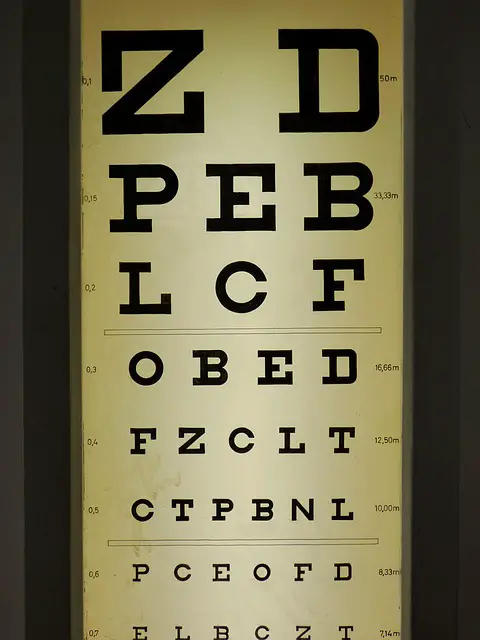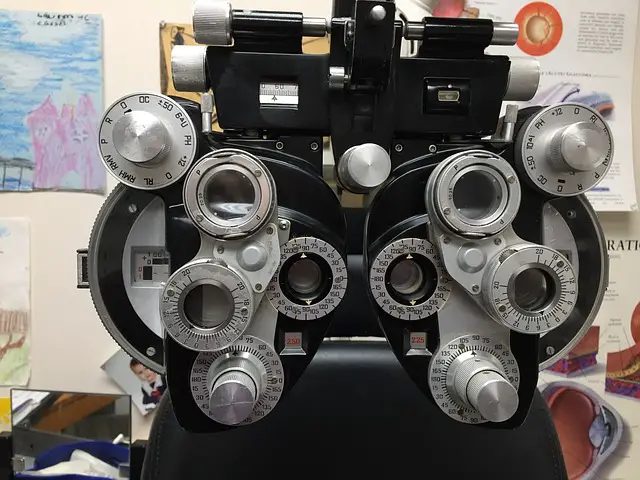Farsightedness (hyperopia) is difficulty seeing close objects, while nearsightedness (myopia) is difficulty seeing distant objects.
TL;DR Farsighted Vs. Nearsighted
Nearsightedness, also known as myopia, is a condition where individuals can see nearby objects clearly but struggle with distant vision. It is typically caused by the eyeball being too long or the cornea being too curved. Symptoms of nearsightedness may include blurred vision when looking at distant objects, headaches, and squinting.
For correcting nearsightedness, various measures can be taken. These include wearing prescription eyeglasses, contact lenses, or considering refractive surgery such as LASIK or PRK.
Farsightedness, also known as hyperopia, is the opposite of nearsightedness. Individuals with farsightedness can see distant objects more clearly, but nearby objects appear blurry. This occurs when the eyeball is slightly shorter than normal or the cornea is too flat. Symptoms may include difficulty focusing on close-up tasks, eye strain, and headaches.
To correct farsightedness, options like prescription eyeglasses, contact lenses, or refractive surgeries can be considered.
Understanding Vision Conditions: Nearsightedness and Farsightedness
Nearsightedness and farsightedness are two common vision conditions that affect how clearly a person can see objects at different distances. Here is a breakdown of each condition:
- Nearsightedness (Myopia): People with nearsightedness have difficulty seeing objects that are far away but can see close-up objects clearly. This occurs when the eyeball is slightly longer than normal or when the cornea is too curved, causing light to focus in front of the retina instead of directly on it. As a result, distant objects appear blurry.
- Farsightedness (Hyperopia): Farsighted individuals have difficulty seeing nearby objects clearly but can see objects at a distance more clearly. Farsightedness occurs when the eyeball is shorter than normal or when the cornea is flatter, causing light to focus behind the retina instead of directly on it. This makes close-up objects appear blurry.
Key differences between nearsightedness and farsightedness include:
- Distance Focus: Nearsightedness affects distance vision, while farsightedness affects near vision.
- Symptoms: Nearsighted individuals may experience squinting, headaches, or eyestrain when trying to see distant objects clearly. Farsighted individuals may experience eye strain, fatigue, or discomfort when focusing on close-up tasks.
- Correction: Nearsightedness is typically corrected with concave (minus) lenses, which help focus light directly onto the retina. Farsightedness is corrected with convex (plus) lenses, which help bring light forward to focus on the retina.
- Related Conditions: Nearsighted individuals may also have an increased risk of developing conditions such as retinal detachment or glaucoma. Farsighted individuals may be more prone to eye strain or crossed eyes (strabismus).
If you experience vision problems, it is important to visit an eye care professional who can accurately diagnose your condition and recommend appropriate corrective measures, such as glasses, contact lenses, or refractive surgery.
Definition of Nearsightedness

Nearsightedness, also known as myopia, is a common refractive error of the eye that affects how well a person can see objects in the distance.
In nearsightedness, the eye focuses light in front of the retina instead of directly on it. As a result, distant objects appear blurry or out of focus, while close-up objects may still be clear.
The main cause of nearsightedness is an eyeball that is too long or a cornea that is too curved. These abnormalities prevent light from properly reaching the retina, resulting in the blurred vision associated with nearsightedness.
Nearsightedness can vary in severity, with some individuals experiencing mild nearsightedness and others having a more significant degree of nearsightedness. It is typically diagnosed through a comprehensive eye examination conducted by an optometrist or ophthalmologist.
To correct nearsightedness, individuals often rely on prescription eyeglasses or contact lenses that help to focus light onto the retina properly. In some cases, refractive surgery, such as LASIK, may be an option to permanently correct nearsightedness.
It is important to regularly monitor nearsightedness, as it may progress over time, particularly during childhood and teenage years. Routine eye exams can detect any changes and help ensure appropriate vision correction measures are in place.
Causes of Nearsightedness
The causes of nearsightedness, also known as myopia, can be attributed to several factors:
- Genetics: Myopia tends to run in families, suggesting a genetic predisposition. If one or both parents are nearsighted, there is a higher likelihood of their children developing nearsightedness.
- Environmental Factors: Certain environmental factors can contribute to the development of nearsightedness. Spending excessive time engaged in close-up activities such as reading, using electronic devices, or focusing on nearby objects for prolonged periods may increase the risk.
- Eye Shape: Nearsightedness occurs when the eyeball is slightly elongated or the cornea is more curved than normal. These structural differences cause light entering the eye to focus in front of the retina instead of directly on it, resulting in blurred distance vision.
- Aging: In some cases, nearsightedness can worsen with age. This progression is often observed during childhood and adolescence when the eyes are still growing and developing.
- Medical Conditions: Certain medical conditions, such as diabetes or cataracts, can contribute to the development of nearsightedness. Some medications may have side effects that impact vision.
It is important to consult with an eye care professional for a comprehensive examination and diagnosis to determine the specific causes of nearsightedness in individual cases.
Symptoms of Nearsightedness
The following are common symptoms of nearsightedness:
- Blurry Distance Vision: People with nearsightedness, also known as myopia, often have difficulty seeing objects clearly at a distance. Distant objects appear blurry or out of focus.
- Squinting: To try and improve their vision, individuals with nearsightedness may squint their eyes, which temporarily adjusts the shape of the eye and allows them to see more clearly.
- Headaches and Eye Strain: Straining to see distant objects for extended periods can lead to headaches and eye strain. This discomfort may occur after activities such as driving, watching a movie in a theater, or trying to read signs in the distance.
- Difficulty Seeing at Night: Nearsightedness can also cause difficulty seeing in low-light conditions or at night. The reduced ability to focus on distant objects can make it challenging to navigate in dimly lit environments.
- Necessity for Reading Glasses: While nearsighted individuals have trouble seeing objects far away, they typically have no difficulty seeing objects up close. As a result, they may not need reading glasses or corrective lenses for close-up tasks like reading or using a computer.
- Rapid Eye Movement: Some individuals with nearsightedness may experience rapid eye movement or have difficulty maintaining focus when shifting their gaze from near to far objects.
If you are experiencing any of these symptoms, it is recommended to visit an eye care professional for a comprehensive eye exam to determine if nearsightedness is the cause.
Corrective Measures for Nearsightedness
When it comes to nearsightedness, there are several corrective measures available:
- Prescription Glasses: The most common and straightforward way to correct nearsightedness is by wearing prescription glasses. These glasses have lenses that are specifically designed to compensate for the refractive error, allowing the person to see distant objects more clearly.
- Contact Lenses: Contact lenses are another popular option for correcting nearsightedness. They work by directly sitting on the eye’s surface and providing the necessary refractive correction. Contact lenses offer a wider field of view and freedom of movement compared to glasses.
- Refractive Surgery: For those seeking a more permanent solution, refractive surgery can be considered. Procedures such as LASIK (Laser-Assisted In Situ Keratomileusis) and PRK (Photorefractive Keratectomy) reshape the cornea to correct the refractive error, allowing improved vision without the need for glasses or contact lenses.
- Orthokeratology: Orthokeratology, also known as “ortho-k”, involves wearing specially designed rigid gas permeable contact lenses overnight. These lenses temporarily reshape the cornea, providing clear vision during the day without the need for glasses or contact lenses. This effect is reversible, and regular use is necessary to maintain the vision correction.
- Refractive Lens Exchange: Refractive lens exchange is a surgical procedure where the eye’s natural lens is replaced with an artificial intraocular lens. This procedure is typically recommended for individuals with high degrees of nearsightedness or those who have other eye conditions.
It is essential to consult with an eye care professional to determine the most suitable corrective measure for your nearsightedness based on factors such as your prescription, lifestyle, and overall eye health.
Definition of Farsightedness

Farsightedness, also known as hyperopia, is a refractive error of the eye that affects a person’s ability to see nearby objects clearly.
Individuals with farsightedness have difficulty focusing on objects that are close to them, but their distance vision is usually unaffected or only slightly blurred.
This condition occurs when the eyeball is shorter than normal or when the cornea (the clear front surface of the eye) has too little curvature. As a result, light entering the eye focuses behind the retina instead of directly on it, causing distant objects to appear clear, but nearby objects to appear blurry.
Farsightedness is a common refractive error and can be present from birth or develop gradually over time. It can be diagnosed through a comprehensive eye examination, which may involve visual acuity tests and the use of specialized equipment.
Corrective measures for farsightedness include eyeglasses, contact lenses, or refractive surgery such as LASIK. These methods help redirect light rays onto the retina, allowing for clear vision at all distances.
Causes of Farsightedness
Farsightedness, also known as hyperopia, is a common refractive error that affects vision. The following are some of the main causes of farsightedness:
- Abnormal Eye Shape: Farsightedness can occur when the eyeball is shorter than normal or when the cornea has a flatter curvature. These abnormalities prevent light from focusing directly on the retina, causing it to focus behind the retina instead.
- Genetics: Farsightedness can run in families, indicating a genetic predisposition. If one or both parents have farsightedness, there is a higher chance that their children will also develop the condition.
- Aging: As we age, the lens of the eye becomes less flexible, making it harder to focus on nearby objects. This age-related farsightedness is called presbyopia and typically occurs around the age of 40.
- Medical Conditions: Certain medical conditions, such as diabetes, can contribute to the development of farsightedness. Eye conditions like cataracts or retinopathy may also cause or worsen farsightedness.
- Environmental Factors: Prolonged exposure to certain environmental factors, such as excessive near work or extended periods of time spent looking at screens, may contribute to the development or progression of farsightedness.
If you experience symptoms of farsightedness, such as difficulty focusing on nearby objects or eye strain, it is important to visit an eye care professional for a comprehensive eye examination. They can diagnose the cause of your farsightedness and recommend appropriate corrective measures, such as glasses or contact lenses, to improve your vision.
Symptoms of Farsightedness
Farsightedness, also known as hyperopia, is a common refractive error. Here are some common symptoms of farsightedness:
- Difficulty seeing up close: Individuals with farsightedness may experience difficulty seeing objects that are close to them, such as reading a book or working on a computer.
- Blurry vision: Objects that are nearby may appear blurry or out of focus for individuals with farsightedness.
- Eye strain: Farsightedness can lead to eye strain, especially after prolonged periods of focusing on close-up tasks.
- Headaches: Some people with farsightedness may experience frequent headaches, particularly after engaging in near work for an extended period.
- Squinting: To compensate for the blurred vision, individuals with farsightedness often squint their eyes to try to improve focus.
- Eye discomfort: Farsightedness can cause eye discomfort or a feeling of tiredness in the eyes, especially after performing tasks that require close vision.
- Difficulty with night vision: Farsightedness can also affect night vision, making it harder to see clearly in low-light conditions.
If you are experiencing any of these symptoms, it is advisable to consult an eye care professional for a comprehensive eye examination. They can accurately diagnose farsightedness and recommend appropriate corrective measures such as glasses or contact lenses to improve your vision.
Corrective Measures for Farsightedness
To correct farsightedness, also known as hyperopia, several corrective measures are available:
- Eyeglasses: Prescription eyeglasses with lenses that have a positive power (convex lenses) are commonly prescribed to correct farsightedness. These lenses help focus light directly onto the retina, improving near vision.
- Contact Lenses: Soft contact lenses or rigid gas permeable (RGP) lenses can also be used to correct farsightedness. These lenses alter the way light enters the eye, compensating for the refractive error and providing clearer vision.
- Refractive Surgery: Procedures like LASIK or PRK (photorefractive keratectomy) can be considered for more permanent correction of farsightedness. These surgeries reshape the cornea to improve its focusing power and reduce reliance on glasses or contact lenses.
- Implantable Lenses: In some cases, an artificial lens called an intraocular lens (IOL) can be implanted in the eye to correct farsightedness. This is typically done in cases where refractive surgery is not suitable or when cataract surgery is performed.
It is important to consult with an eye care professional to determine the most suitable corrective measure for your specific condition and lifestyle. They will consider factors such as the degree of farsightedness, age, overall eye health, and personal preferences before recommending the appropriate option.
Explanation of Focusing Issues
Focusing issues can cause two common vision conditions: farsightedness and nearsightedness. Here’s an explanation of each:
Farsightedness (Hyperopia): Farsighted individuals have difficulty focusing on objects that are close to them, but can see distant objects clearly. This occurs when the eyeball is shorter than normal or the cornea is too flat, causing light entering the eye to focus behind the retina instead of directly on it. Farsightedness can lead to eyestrain, headaches, and blurred vision when performing close-up tasks.
Nearsightedness (Myopia): Nearsighted individuals can see nearby objects clearly, but distant objects appear blurry. This occurs when the eyeball is longer than normal or the cornea is too curved, causing light to focus in front of the retina instead of directly on it. Nearsightedness can be hereditary and often develops during childhood or adolescence. It can be corrected with glasses, contact lenses, or refractive surgery.
Both farsightedness and nearsightedness are refractive errors that affect the way light is focused on the retina, resulting in blurred vision. The appropriate corrective lenses or refractive procedures can help individuals with these conditions achieve clear vision and improve their quality of life.
Impact on Near and Far Vision
The difference between being farsighted (hyperopia) and nearsighted (myopia) has a significant impact on both near and far vision. Here’s how:
- Farsightedness (Hyperopia): People who are farsighted have difficulty seeing objects up close but can see distant objects more clearly. This occurs because the eyeball is shorter or the cornea is flatter, causing light to focus behind the retina instead of directly on it. As a result, close-up objects appear blurry, while distant objects remain relatively clear.
- Nearsightedness (Myopia): Nearsighted individuals have clear vision when looking at close objects, but distant objects appear blurry. This happens when the eyeball is longer or the cornea is steeper, causing light to focus in front of the retina instead of directly on it. As a result, faraway objects appear blurry, while close-up objects remain relatively clear.
The impact of farsightedness and nearsightedness on vision is as follows:
- Near Vision: Farsighted individuals may struggle with tasks that require close-up focus, such as reading, writing, or working on a computer. They may experience eye strain, headaches, and fatigue when engaging in prolonged near work. Nearsighted individuals, on the other hand, typically have good near vision and can perform close-up tasks without difficulty.
- Far Vision: Farsighted individuals tend to have clearer distance vision compared to near vision. They may see distant objects more clearly but may still experience some blurriness or eye strain if the hyperopia is significant. Nearsighted individuals have difficulty seeing distant objects clearly and may need to rely on glasses or contact lenses to improve their distance vision.
Age-Related Changes
Age-related changes play a significant role in the difference between farsightedness and nearsightedness. As individuals age, they may experience the following:
- Presbyopia: Presbyopia is an age-related condition that affects the ability to focus on near objects. As people reach their mid-40s or early 50s, the lens of the eye becomes less flexible, making it difficult to focus on close-up objects. This condition is associated with farsightedness and may require the use of reading glasses or bifocals.
- Loss of Accommodation: Accommodation refers to the eye’s ability to adjust its focus from near to far distances. With age, the eye’s ability to accommodate decreases. This can contribute to difficulties with both near and distance vision, impacting individuals who are farsighted or nearsighted.
- Increased Risk of Cataracts: Cataracts are another age-related change that can affect vision. Cataracts cause clouding of the eye’s lens, leading to blurry or hazy vision. While cataracts can impact individuals with both farsightedness and nearsightedness, they can further exacerbate vision problems for those who already have these refractive errors.
- Retinal Changes: As individuals age, they may experience changes in the retina, such as thinning or degeneration. These changes can affect visual acuity and may contribute to vision difficulties associated with both farsightedness and nearsightedness.
Understanding these age-related changes can help individuals better comprehend the differences between farsightedness and nearsightedness and the impact these conditions can have on their vision as they grow older.
Genetic Factors
Genetic factors play a significant role in determining whether a person is farsighted or nearsighted. Here are the key points to understand:
- Farsightedness (Hyperopia): Farsightedness is often caused by genetic factors. If one or both parents have farsightedness, there is an increased likelihood that their children will also develop this condition. Certain genes associated with the shape and size of the eye can contribute to farsightedness.
- Nearsightedness (Myopia): Genetic factors play a significant role in the development of nearsightedness as well. If one or both parents are nearsighted, there is a higher chance that their children will also be nearsighted. Multiple genes are involved in the growth and development of the eyeball, which can influence the occurrence of myopia.
- Complex Interplay: It’s important to note that while genetic factors have a strong influence on farsightedness and nearsightedness, they are not the sole determining factor. Environmental factors such as prolonged near work (e.g., reading, computer use) and lifestyle choices can also contribute to the development and progression of these conditions.
- Personal Variations: Genetic factors can result in variations in the severity and age of onset for farsightedness and nearsightedness. Some individuals may have a higher degree of farsightedness or nearsightedness due to specific genetic factors, while others may experience changes in their refractive error at different stages of life.
- Consult an Eye Care Professional: If you have concerns about your vision or the potential genetic factors contributing to farsightedness or nearsightedness, it is recommended to consult with an eye care professional. They can conduct a thorough examination, assess the impact of genetics, and provide appropriate guidance and treatment options.
Frequently Asked Questions
What is farsightedness?
Farsightedness, also known as hyperopia, is a refractive condition where distant objects are clear, but close-up objects appear blurry. This occurs when the eyeball is too short or the lens lacks curvature, causing light to focus beyond the retina.
What is nearsightedness?
Nearsightedness, or myopia, is the opposite of farsightedness. It occurs when distant objects are blurry and close-up objects are clear. This happens when the eyeball is too long, causing light to focus in front of the retina.
How does farsightedness affect vision?
Farsightedness affects near vision. People who are farsighted have trouble seeing objects up close clearly, but can see distant objects well.
How does nearsightedness affect vision?
Nearsightedness affects distance vision. People who are nearsighted have difficulty seeing objects in the distance clearly, but can see objects up close clearly.
How are farsightedness and nearsightedness treated?
Both farsightedness and nearsightedness can be improved with corrective lenses, such as eyeglasses or contacts. LASIK surgery is also an option for correcting vision in both conditions.
Can someone be both farsighted and nearsighted?
Yes, it is possible for an individual to have both nearsightedness and farsightedness. This means they would have difficulties seeing objects up close and at a distance.
Image Credits
Featured Image By – Gary Cassel from Pixabay
Image 1 By – Marc Pascual from Pixabay
Image 2 By – Felix Wolf from Pixabay









